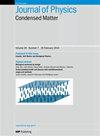多晶体中的晶间散射。
IF 2.3
4区 物理与天体物理
Q3 PHYSICS, CONDENSED MATTER
引用次数: 0
摘要
利用量子散射理论从第一原理描述了多晶体中晶粒边界的传输,其中明确包括费什巴赫共振,以解释间歇捕获的电子表面态。推导出有效的 $T$ 矩阵,然后用于计算电导率,电导率在临界晶间偏置时会出现击穿和急剧上升。在电子热能 $k_BT$ 远远小于晶间势垒高度 $\varphi_b$ 的典型条件下,电导率的形式为 $\sigma \sim T^{-1/2} e^{-\varphi_b/k_BT}$ 。在压缩晶粒中可能会出现的相反情况下,我们也考虑了单晶晶粒电导率与温度和偏置的函数关系。本文章由计算机程序翻译,如有差异,请以英文原文为准。
Intergrain scattering in polycrystals.
Transport through grain boundaries in polycrystals is described from first principles using quantum scattering theory, explicitly including Feshbach resonances to account for intermittently trapped electronic surface states. An effectiveT-matrix is derived then used to calculate the electrical conductivity which exhibits breakdown, a sharp increase at a critical intergrain bias. Under typical conditions where the electron thermal energy,kBT, is much less than the intergrain barrier height,φb, the electrical conductivity has the formσ∼T-1/2e-φb/kBT. Temperature dependence of the conductivity is also considered for thermal energies much larger than the applied bias, as may be realized in tightly-compressed grains.
求助全文
通过发布文献求助,成功后即可免费获取论文全文。
去求助
来源期刊

Journal of Physics: Condensed Matter
物理-物理:凝聚态物理
CiteScore
5.30
自引率
7.40%
发文量
1288
审稿时长
2.1 months
期刊介绍:
Journal of Physics: Condensed Matter covers the whole of condensed matter physics including soft condensed matter and nanostructures. Papers may report experimental, theoretical and simulation studies. Note that papers must contain fundamental condensed matter science: papers reporting methods of materials preparation or properties of materials without novel condensed matter content will not be accepted.
 求助内容:
求助内容: 应助结果提醒方式:
应助结果提醒方式:


